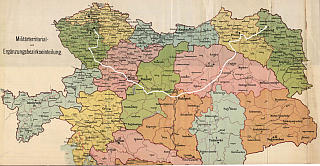
Švejk's journey on a of Austria-Hungary from 1914, showing the military districts of k.u.k. Heer. The entire plot of The Good Soldier Švejk is set on the territory of the former Dual Monarchy.
The Fateful Adventures of the Good Soldier Švejk (mostly known as The Good Soldier Švejk) by Jaroslav Hašek is a novel that contains a wealth of geographical references - either directly through the plot, in dialogues or in the author's narrative. Hašek was himself unusually well travelled and had a photographic memory of geographical (and other) details. It is evident that he put a lot of emphasis on geography: Eight of the 27 chapter headlines in the novel contain geographical names.
This web site will in due course contain a full overview of all the geographical references in the novel; from Prague in the introduction to Klimontów in the unfinished Part Four. Continents, states (also defunct), cities, market squares, city gates, regions, districts, towns, villages, mountains, mountain passes, oceans, lakes, rivers, caves, channels, islands, streets, parks and bridges are included.
The list is sorted according to the order in which the names appear in the novel. The chapter headlines are from Zenny Sadlon's recent translation (1999-2024) and will in most cases differ from Cecil Parrott's translation from 1973.
The quotes in Czech are copied from the on-line version of The Good Soldier Švejk: provided by Jaroslav Šerák and contain links to the relevant chapter. The toolbar has links for direct access to Wikipedia, Google maps, Google search, svejkmuseum.cz and the novel on-line.
The names are coloured according to their role in the novel, illustrated by these examples: Sanok a location where the plot takes place, Dubno mentioned in the narrative, Zagreb part of a dialogue, and Pakoměřice mentioned in an anecdote.
 Places index of countries, cities, villages, mountains, rivers, bridges ... (592)
Show all
Places index of countries, cities, villages, mountains, rivers, bridges ... (592)
Show all I. In the rear
I. In the rear  14. Švejk as military servant to senior lieutenant Lukáš (60)
14. Švejk as military servant to senior lieutenant Lukáš (60) II. At the front
II. At the front  2. Švejk's budějovická anabasis (64)
2. Švejk's budějovická anabasis (64) 3. Švejk's happenings in Királyhida (43)
3. Švejk's happenings in Királyhida (43) III. The famous thrashing
III. The famous thrashing  1. Across Magyaria (38)
1. Across Magyaria (38) 2. In Budapest (38)
2. In Budapest (38) 3. From Hatvan to the borders of Galicia (50)
3. From Hatvan to the borders of Galicia (50) 4. Forward March! (42)
4. Forward March! (42)



|
I. In the rear |
 | |
13. Švejk goes to provide the last rites | |||
 | Dlouhá třída |  | ||||
| ||||||
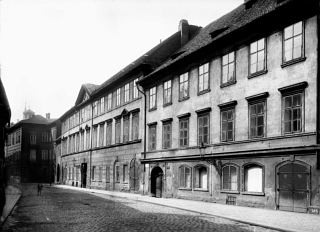
Pohled do Dlouhé ulice s domy (zprava) čp. 740 ('U Záplatky'), 741 ('U Červeného raka'), 743 na Starém Městě před zbořením roku 1899.
Dlouhá třída is the street where firma Polák, trading in oil and varnish, were located. Švejk bought oil consecrated by a bishop: Hempseed oil No. 3.
Background
Dlouhá třída is a street in Staré město (Old Town), Prague. It extends from Staroměstské náměstí towards Poříčí and is one of the oldest streets in the city.
Quote(s) from the novel
[I.13] V druhé chtěli telefonovat na ochrannou stanici a ve třetí mu řekl provisor, že firma Polák v Dlouhé třídě, obchod olejem a laky, bude mít rozhodně žádaný olej na skladě.
Also written:Langengassede
 | Žižkov |  | |||
| |||||

Karlova třída in 1915 (now Seifertova)
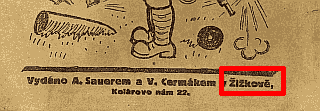
Osudy dobrého vojáka Švejka, 1921
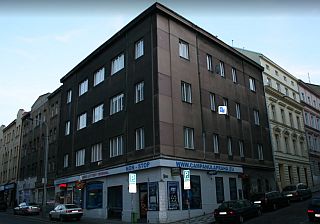
Jeronýmova 324/8 (2010). This is where the first part of the novel was written in 1921.
Žižkov is mentioned 9 times in The Good Soldier Švejk.
Žižkov is here mentioned in an anecdote about a priest, but the district (in 1914 a separate city) appears several times throughout the novel without the plot ever being explicitly set here.
Amongst them is the sequence where Švejk ask for the way here and asks the maid of Oberst Kraus about the habits of the dog he is planning to steal. He also mentions Doctor Masák who helped Einjährigfreiwilliger Marek prolong his stay at Budějovická nemocnice. Žižkov is also mentioned in connection with Professor Axamit.
Background
Žižkov is an urban district and cadastral area east of the centre of Prague. Administratively it is part of Prague 3 and partly Prague 8. The district as named after the Hussite leader Jan Žižka. From 1881 to 1922 it was a city in its own right.
The first and part of the second volume of The Good Soldier Švejk was written here. Jaroslav Hašek stayed with his friend Franta Sauer at Jeronýmova 324/3 from January to August 1921. Nearby at Prokopovo náměstí there is now a statue of the author.
Demography
According to the 1910 census Žižkov had 72,173 inhabitants of whom 70,174 (97 per cent) reported using Czech in their daily speech. The judicial district was okres Žižkov, administratively it reported to hejtmanství Žižkov.
Source:Seznam míst v království Českém(1913)
Military
Per the recruitment districts, infantrymen from Žižkov were usually assigned to Infanterieregiment Nr. 28 (Prag) or k.k. Landwehrinfanterieregiment Nr. 8 (Prag).
Quote(s) from the novel
[I.13] Na Žižkově jednou farář zmlátil jednoho slepýho, že při takovej příležitosti nesmek, a eště byl zavřenej, poněvadž mu u soudu dokázali, že není hluchoněmej, a jenom slepej, a že slyšel cinkot zvonečku a budil pohoršení, ačkoliv to bylo v noci.
[I.14] Švejk ji oslovil: „Dovolte, slečno, kudy se jde na Žižkov?“ Zastavila se a podívala se na něho, myslí-li to upřímně, a dobrácký obličej Švejkův jí řekl, že opravdu ten vojáček chce asi jít na Žižkov. Výraz její tváře změkl a ona ochotně mu vykládala, jak na ten Žižkov půjde.
[II.2] Do Budějovic byl přeložen můj pošvagřenec dr. Masák ze Žižkova a tomu mohu děkovat, že jsem se tak dlouho v nemocnici udržel.
[II.3] Ve plentě byl otvor a každej moh vidět v takovej polotmě prachvobyčejný kanape a na něm se válela jedna ženská ze Žižkova.
[II.3] Potom ještě řekl Paroubkovi, že je huncút a šaščínská bestie, tak ho milej Paroubek chyt, votlouk mu jeho pastě na myši a dráty vo hlavu a vyhodil ho ven a mlátil ho po ulici tyčí na stahování rolety až dolů na Invalidovnu a hnal ho, jak byl zdivočelej, přes Invalidovnu v Karlíně až nahoru na Žižkov, vodtud přes Židovský pece do Malešic, kde vo něj konečně tyč přerazil, takže se moh vrátit nazpátek do Libně.
[III.2] To je na Žižkově pan profesor Axamit a ten tam kopal, hledal hroby skrčenců a několik jich vybral, a voni si ho, toho flašinetáře, vodtáhly do jedný takový vykopaný mohyly a tam ho dřely a zneužívaly.
Literature
- Franta Habán ze Žižkova, ,1923
- Švejk slaví sto let, ,3.6.2021
- Zbabělý hrdina, ,19.11.1923
- Jeronýmova 324/8, Žižkov,
 | Malešice |  | |||
| |||||

Malešice, 1974
Malešice is mentoned in an anecdote Švejk uses as a parallell to the persistent money lender. The soldier refers to a landlord who for any occasion can show up with a quote from the Bible. Later the place appears in the anecdote about liquor trader Paroubek.
Background
Malešice is an urban district in eastern Prague, located in Prague 10 and Prague 9 respectively. It became part of the capital in 1922.
Demography
According to the 1910 census Malešice had 1,114 inhabitants of whom 1,109 (99 per cent) reported using Czech in their daily speech. The judicial district was okres Žižkov, administratively it reported to hejtmanství Žižkov.
Source:Seznam míst v království Českém(1913)
Military
Per the recruitment districts, infantrymen from Malešice were usually assigned to Infanterieregiment Nr. 28 (Prag) or k.k. Landwehrinfanterieregiment Nr. 8 (Prag).
Quote(s) from the novel
[I.13] V Malešicích byl jeden šenkýř, písmák, který na všechno měl citáty z Písma svatýho, a když někoho pral bejkovcem, vždycky říkal: ,Kdo šetří metly, nenávidí syna svého; ale kdo ho miluje, včas jej tresce, já ti dám prát se mi v hospodě.’“
[II.3] Potom ještě řekl Paroubkovi, že je huncút a šaščínská bestie, tak ho milej Paroubek chyt, votlouk mu jeho pastě na myši a dráty vo hlavu a vyhodil ho ven a mlátil ho po ulici tyčí na stahování rolety až dolů na Invalidovnu a hnal ho, jak byl zdivočelej, přes Invalidovnu v Karlíně až nahoru na Žižkov, vodtud přes Židovský pece do Malešic, kde vo něj konečně tyč přerazil, takže se moh vrátit nazpátek do Libně.
 | Bordeaux |  | ||||
| ||||||

,10.12.1893

,31.12.1899
Bordeaux is indirectly mentioned by Feldkurat Katz when he suggests to Švejk that they prepare a Bordeaux punch.
Background
Bordeaux is a city in south western France with appx. 250,000 inhabitants (the urban area appx. 1 million). Det is centre of the wine growing region of the same name and it is this connection that makes its way into the novel.
Bordeaux-punch
This variety of punch may not be well known term today, but an internet search reveals a punch based on red wine. Bordeaux is obviously connected to the this very ingredient because the area around this French city is a famous wine growing region.
The drink was also on sale in bottles, as adverts bear witness to. The best known was a brand seems to have been E. Lichtwizt & Co from Opava (Troppau) who were also suppliers to the imperial and royal court. Even more common were concentrated flavours in bottles and these are the ones that appear in the earliest adverts. The first mention of Bordeaux-punch that can be traced in the Austrian press is from 1845 and refers to an event at Sofien-Insel in Prague (now Slovanský ostrov).
In the handwritten manuscript of The Good Soldier Švejk (page 127) Feldkurat Katz uses the term "bordeux-punč". This and some other minor errors were corrected in post-World War II editions of the novel.
Quote(s) from the novel
[I.13] "Vidíte, Švejku, jak to dopadá s takovým člověkem, který nectí kněze," usmál se polní kurát. "Svatý Jan Zlatoústý řekl: ,Kdo ctí kněze, ctí Krista, kdo příkoří činí knězi, činí příkoří Kristu Pánu, jehož zástupcem právě kněz jest.` - Na zítřek musíme se dokonale připravit. Udělejte smažená vajíčka se šunkou, uvařte Bordeaux punč a potom věnujeme se rozjímání, neboť jak je v modlitbě večerní: ,Odvráceny jsou milostí boží všechny úklady nepřátel o tento příbytek.` "
Credit: Sergey Soloukh
Literature
- Bordeaux punč,
- Prag (Schluss), ,5.4.1845
- Brève chronique et recette du Punch, ,13.2.1913
 | Drina |  | ||||
| ||||||

БИТКА НА ДРИНИ: 101 година од крвавих борби у Подрињу.
,8.9.2015

,1924-1928
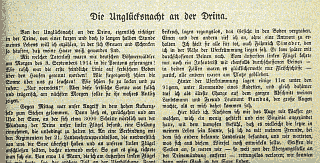
About the fatal attempt to cross the Drina on 8.9.1914.
,1924-1928
Drina is first mentioned by the moneylender who pestered Feldkurat Katz. He complains that Oberleutnant Janata had been cheeky enough to get killed by the Drina, despite owing him 700 crowns.
Drina is later mentioned several times, particlularly in Királyhida where veterans relate from the campaign against Serbia in 1914. Here the author reveals that Major Wenzl had proved his utter incompetence by ordering the destruction of a pontoon-bridge across Drina despite of the fact that half his battalion were stranded on the opposite bank.
Background
Drina is a river in the Balkans, and one the tributaries to Sava. Stretching 346 km, it is the border between Bosnia-Hercegovina and Serbia, in 1914 effectively the border between Austria-Hungary and Serbia.
IR. 91 by Drina
Infanterieregiment Nr. 91 and 9. Infanteriedivision took part of the campaign against Serbia from August to December 1914. Amongst those participating where several of the officers that Jaroslav Hašek used as models for characters in The Good Soldier Švejk: Rudolf Lukas, Čeněk Sagner, Josef Adamička, and Franz Wenzel (the latter from mid August). As an officer's servant František Strašlipka presumably accompanied Lukas already then.
The regiment arrived in Gunja by the Sava on 4 August after a three day train journey from Budějovice. They immediately continued by ship and foot to the assembly area by Bjelina (now Bijeljina), where they arrived the next day. On 12 August they crossed the river on pontoon bridges by Novoselo and took part on the bloody battle of Cer from 16 to 19 August. Suffering heavy losses they withdrew and were back on the Bosnian bank on the river by 20 August.
On 8 September 1914 the division took part in another attempt to invade Serbia, during the so-called battle of Drina. This time the point of crossing the river was by the confluence with Sava. It ended in disaster, and IR. 91 lost more than 700 men dead, wounded and missing. Although initially able to cross on pontoon bridges, they were forced back, and in the night they were ordered to retreat across the river. But the bridges had been destroyed, and subjected to devastating Serbian fire, panic broke out. Many threw themselves into the river and nearly all of them drowned. IR. 91 remained on the west bank of the Drina until 26 September when they were transferred to the northern bank of the Sava. This was the last time they were stationed by this river.
E.E. Kisch
The famous reporter Egon Erwin Kisch kept a diary during him time with Infanterieregiment Nr. 11 in Serbia. His regiment, recruited from the Písek military district, belonged, like Infanterieregiment Nr. 91, to 9. Infanteriedivision and took part in the same battles under the same circumstances. In this moving and well-written book titled Schreib das auf Kisch!. The author describes the hardship and sufferings the soldiers were subjected to, about the horrendous losses, about the incompetence at all levels, morally deprived officers, about chaos and confusion, about the false description of the real situation that people at home were served. Kisch's book contains much that the reader of The Good Soldier Švejk will recognize.
Quote(s) from the novel
[I.13] Nadporučík Janata dluhoval mně 700 korun a odvážil se padnout na Drině.
[II.3] Švejk seděl na odestlané posteli nadporučíkově a naproti němu seděl na stole sluha majora Wenzla. Major se opět vrátil k regimentu, když byla v Srbsku konstatována jeho úplná neschopnost na Drině.
[II.4] To jsme stáli na Drině. A jednou v noci, když byl pryč, tak někomu napadlo šťourat se v jeho věcech, a pacholek měl v ruksaku celý tři krabičky po stovce športek.
[II.4] Potom jsme na něho navlíkli jeho ruksak i s cigaretama a hodili ho pěkně do Driny. Kdopak by takový cigarety kouřil. Ráno byla po něm sháňka."
[II.4] Každej den někdo zmizel, a ani už to z Driny nelovili. Plaval tam nadmutej čúžák vedle našeho rozflákanýho landveráka hezky po Drině do Dunaje. Někteří nezkušení, když to viděli ponejprv, tak dostali malinkou horečku.
Credit: Gustav Jungbauer, Rudolf Kießwetter, Egon Erwin Kisch, VÚA
Also written:Дринаsr
Literature
- Blutkarte, ,1924-1928
- Battle of Cer,
- Battle of Drina,
- Das Lächeln der Henker, Anton Holzer,5.10.2008
 | Rawa Ruska |  | ||||
| ||||||
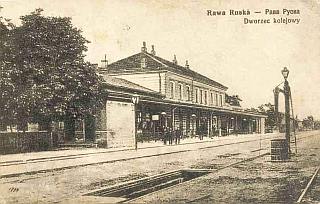
The railway station
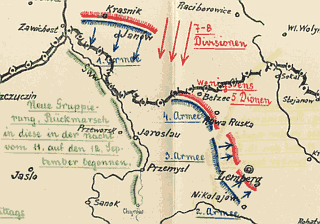
Kaiserbericht, 11.9.1914
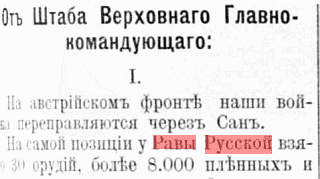
,15.9.1914
Rawa Ruska is mentioned by the persisting money-lender when he complains to the reluctant Feldkurat Katz that captain Hauptmann Wichterle had let himself get killed by his own soldiers despite owing 2000 crowns.
Background
Rawa Ruska is the Polish name of Рава-Руська (Rava-Ruska), a town and railway junction in Galicia, near the current border between Ukraine and Poland. The town is administratively part of Lviv oblast, Until 1918 it was part of Austria-Hungary, in the inter-war period it belonged to Poland, since 1945 the Soviet Union and from 1991 Ukraine.
Rawa Ruska was during Austria-Hungary rule part of Ergänzungsbezirk Nr. 30 that again belonged to Korpsbezirk Nr. 11 (both Lwów). Infantry soldiers from the area would this have been enrolled in Infanterieregiment Nr. 30.
The battle of Rawa Ruska
The fragment from the novel refers to the battle of Rawa Ruska that took place from 6 to 11 September 1914 between the armies of Austria-Hungary and Russia.
The outcome was a catastrophic defeat for k.u.k. Wehrmacht who were forced to withdraw to a defensive line along the river San and the Carpathians range, and in effect abandon most of Galicia. Hardest hit was Brudermann's third army. The withdrawal started in the early hours of 12 September and on that day Russian forces occupied Rawa Ruska itself. One of the casualties of the battle was Herbert Conrad von Hötzendorf, son of Chief of General Staff, Feldmarschall Conrad.
The Central Powers were only to return on 21 June 1915 when the town was conquered by German troops.
Demography
According to the 1910 census Rawa Ruska had 10 440 inhabitants. The judicial district was Gerichtsbezirk Rawa Ruska, administratively it reported to Bezirkshauptmannschaft Rawa Ruska.
Military
Per the recruitment districts, infantrymen from Rawa Ruska were usually assigned to Infanterieregiment Nr. 89 (Gródek) or k.k. Landwehrinfanterieregiment Nr. 34 (Jaroslau).
Deutsche Heeresbericht, 21. Juni 1915
Die Armeen des Generalobersten v. Mackensen kämpfen um Lemberg und Zolkiew; Rawa-Ruska ist in unserer Hand. Westlich Rawa-Ruska wurde der Feind gestern von deutschen Truppen angegriffen und geworfen.
Quote(s) from the novel
[I.13] Hejtman Wichterle, dluhující mně stejný obnos, dal se zabít pod Ruskou Ravou vlastními vojáky.
Also written:Ruská RavaHašekRawa-RuskadeРава-РусскаяruРава-Руськаua
Literature
- Słownik geograficzny Królestwa Polskiego..., ,1880 - 1914
- Schlacht bei Rawa Ruska,
- Petrograd, 14de September, ,15.9.1914
- Der Sohn des Chefes des Generalstabes gefallen, ,17.9.1914
- Galiziens erövring, ,18.9.1914
- Boje u Ravy Ruské, ,21.6.1915
- Rawa-Ruska besetzt, ,23.6.1915
- Рава-Руська,
 | Carpathians |  | |||
| |||||

,3.1.1915
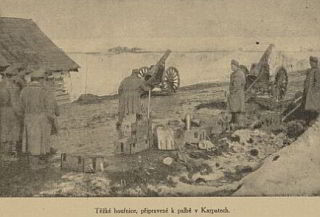
, s.519
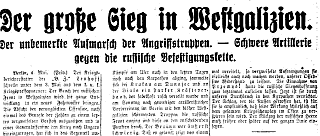
,5.5.1915

, Beilage 15.
Carpathians is mentioned by the money lender who pestered Feldkurat Katz, because yet another officer who owed him money had been killed there. In the same chapter there is a description of two soldiers dying at Vojenská nemocnice na Karlově náměstí. Both had been shot in the stomach.
Carpathians also appears in [I.14] as Oberleutnant Lukáš enters the plot. Švejk reads about events there in the paper when he accompanies Katy Wendler to the barracks where Lukáš teaches one-year volunteers. Later in the chapter the mountains are mentioned by Lukáš in the conversation with hop trader Wendler.
From [III.1] the Carpathians and places in the mountains are mentioned frequently by soldiers who have been there with previous march battalions and tell their stories.
In [III.4] the plot takes place in the Carpathians. See Łupków Pass.
Background
Carpathians is the easternmost of the great mountain ranges of Europe. It extends 1,500 km on the territory of Romania, Czech Republic, Slovakia, Poland, Ukraine, Austria, Serbia and Hungary.
In September 1914 Russian forces pushed into the northern part of the mountain range and in early October they tried to break through the Uszok pass. In November they occupied Humenné for a short while and also entered Hungarian territory in Maramaros (now Maramureș in Romania).
The winter battle
The winter battle in the Carpathians started in December 1914 and lasted until March 1915. The Uszok pass was captured by the Russians in December and Dukla was also for a long time controlled by the Russian army. A third important spot was Lupkow where fierce fighting took place during the winter. In reaching the Laborec valley Russian forces crossed the Karpatane but never managed to force their way through to the Hungarian plain.
K.u.k. Heer attempted several offensives throughout the winter, but the two armies that were involved (2nd and 3rd) were poorly equipped for a winter war and more men froze to death than fell victims of enemy bullets. The Russians also suffered horrendous losses, made worse by the tactic of sending human waves towards the enemy, a tactic the due to machine gun fire ended in mass slaughter.
Gorlice-Tarnów
The end of the war in the Carpathians came in early May 1915 after the Central Powers' advance during and after the battle of Gorlice-Tarnów. Under German command the SEN forced the Russians away from the mountains.
IR. 91 in the Carpathians

IR. 91 left the transport trains by Nagy-Berezna 7 February 1915.
,1924-1928
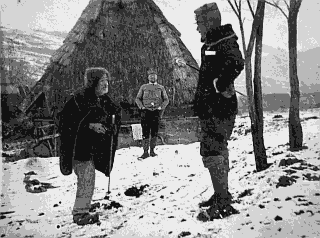
IR. 91 in Jaworzec, March 1915.
© SOkA Beroun
Three battalions (2nd, 3rd and 4th) of Infanterieregiment Nr. 91 fought in the Carpathians from 7 February 1915 until the first week of May. Thereafter they marched across the mountains and pursued the enemy in the direction of Sambor. IR. 91 operated within a relatively small area, near the current border triangle between Slovakia, Poland and Ukraine (see Východní Beskydy).
Commander of the regiment at the time was Oberst Alfred Steinsberg who 1 February 1915 had been transferred from the sister regiment IR73 who belonged to the same division (9th). During the hard winter the cold was often a bigger problem than the enemy. This is reflected in the anecdotes veterans from the Carpathians tell in the novel.
At least four of the real-life models of characters from Švejk served here: Rudolf Lukas, Jan Vaněk, Josef Adamička and Jan Eybl. The former two were wounded in early March and only rejoined the regiment on 11 July with the XII. Marschbataillon. The more peripheral Oberleutnant Wurm also served there, from March 1915.
In Jan Eybl's archive valuable photos from this period exists. Most of them are from Jaworzec where IR. 91 staff was located in March 1915. Eybl's diaries cover the whole period the regiment stayed in the Carpathians.
After 2 May 1915 the situation changed. The Central Power's breakthrough victory by Gorlice-Tarnów forced the Russians away from the mountain range and IR. 91 was among the units that pursued the enemy across the river San and in the direction of Sambor. The regiment marched off from their positions by Kistopolya and Oroszpatak on 4 May, crossed the San a week later and by 15 May they have reached the area by Sambor.
Press quotes

Světová válka 1914-1915 slovem i obrazem, page 505

Světová válka 1914-1915 slovem i obrazem, page 508
In [I.14] there are two near literal quotes from Kronika světové války regarding the Carpathians. These are amongst many snippets from this publication that appear in this part of the novel.
The first quote regards Švejk's considerations at the gate of the barracks where he accompanied Katy Wendler. Almost word for word identical quotes are found in "Kronika" at page 505. It deals with events on 26 March 1915.
The second borrowed quote appears in the conversation between Oberleutnant Lukáš and hop trader Wendler where the officer states that a breakthrough of the Russian front between middle Dunajec and the ridge of the Carpathians will definitely end the war. The source is Kronika světové války page 508 and refers to events by Dunajec on 2 May 1915, the first day of the Gorlice-Tarnów offensive.
Quote(s) from the novel
[I.13] Ten padne v Karpatech s mou nezaplacenou směnkou, ten jde do zajetí, ten se mně utopí v Srbsku, ten umře v Uhrách ve špitále.
[I.13] Po posledním pomazání ve vojenské nemocnici toužili dva. Jeden starý major a jeden bankovní disponent, důstojník v záloze. Oba dostali kulku do břicha v Karpatech a leželi vedle sebe.
[I.14.4] Švejk posadil se na lavici ve vratech a vykládal, že v bitevní frontě karpatské se útoky vojska ztroskotaly, na druhé straně však že velitel Přemyšlu, generál Kusmanek, přijel do Kyjeva a že za námi zůstalo v Srbsku jedenáct opěrných bodů a že Srbové dlouho nevydrží utíkat za našimi vojáky.
[I.14.5] Zatímco masy vojsk připnuté na lesích u Dunajce i Rábu stály pod deštěm granátů a velkokalibrová děla roztrhávala celé setniny a zasypávala je v Karpatech a obzory na všech bojištích hořely od požárů vesnic i měst, prožíval nadporučík Lukáš se Švejk nepříjemnou idylu s dámou, která utekla svému muži a dělala nyní domácí paní.
[I.14.5] Jakmile však prolomíme ruskou frontu mezi karpatským hřbetem a středním Dunajcem, není nijaké pochybnosti, že bude to znamenat konec války.
[I.14.5] V karpatských úsecích, jak vidíte, máme velkou oporu.
[II.2] Přesunutí našich vojsk ve východní Haliči dalo původ k tomu, že některé ruské vojenské části; překročivše Karpaty, zaujaly pozice ve vnitrozemí naší říše, čímž fronta byla přesunuta hlouběji k západu mocnářství.
[II.2] Černožluté obzory počaly se zatahovat mraky revoluce. Na Srbsku, v Karpatech; přecházely batalióny k nepříteli. 28. regiment, 11. regiment.
[II.3] Tam budou formírovat maršbatalióny, vojáci se vycvičí v polní střelbě, se perou se s Maďary a vesele pojedeme do Karpat.
[II.5] Tam to bylo hrozné, pane obrlajtnant, Rusové měli v Karpatech štelungy nahoře i dole. A potom, pane obrlajtnant, pan hejtman Ságner..."
[II.5] To je z Karpat, pane obrlajtnant, tam jsme to museli dělat, mináž k nám přicházela nahoru studená, zákopy jsme měli ve sněhu, oheň se nesměl dělat, tak nás držel jen ten rum.
Credit: Österreich-Ungarns letzter Krieg, Norman Stone, Rudolf Kießwetter, Jan Ev. Eybl
Also written:KarpatyczKarpatendeКарпатыruКарпатиua
Literature
- Das Infanterieregiment Nr. 91 am Vormarsch in Galizien, ,1927
- V Karpatech po stopách jednadevadesátníků,
- Die Verschiebung des Infanterieregemntes Nr. 91 auf den nördlichen Kriegsschauplatz, Karl Wagner-Wagenried,1924-1928
- In den Karpathen, ,1915
- Přehled dosadavních událostí válečných, ,4.4.1915
- Stručná kronika světové války, 26. března, ,10.4.1915
 | Českomoravská vysočina |  | |||
| |||||

From the book "Českomoravská vysočina", 1909.

Vysočina in 2017. View from Lipnice castle.
Českomoravská vysočina (mostly called only Vysočina - The Highland) is mentioned by the author when he describes a group of soldiers with Švejk at the forefront holding a discussion. Then a young soldier from Vysočina who still believed in God entered the discussion. The conversation took place at Vojenská nemocnice na Karlově náměstí.
Background
Českomoravská vysočina (Bohemian-Moravian Highlands) is a historical term for the geographical area that is now called Českomoravská vrchovina (Bohemian-Moravian Highlands).The area roughly corresponds to the modern administrative region of Kraj Vysočina but is slightly bigger. The administrative centre in the modern Vysočina is Jihlava.
Hašek and Vysočina
The highlands are strongly associated with Jaroslav Hašek, mainly because most of The Good Soldier Švejk was written here, more precisely at Lipnice. This is also where he died and where his grave still is. His descendants have since 2003 been running U české koruny, the inn where the author lived from August 1921 to October 1922.
Hašek knew the region well, also from his trips before the war, and mentions several places from Vysočina in the novel. Apart from Lipnice itself he mentions Posázaví, Německý Brod, Chotěboř, Skuteč, Okrouhlice, Kejžlice, Jihlava, Pelhřimov, Jedouchov, Dolní Královice, Velké Meziříčí.
It should be added that when the author wrote this passage of the novel he had not yet moved to Lipnice nad Sázavou.
Quote(s) from the novel
[I.13] Nějaký mladičký vojáček z Českomoravské vysočiny, který ještě věřil v pánaboha, prosil, aby se o takových věcech nevedly řeči a aby se svatá tajemství nezatahovala do debaty. Musíme křesťansky doufat.
Also written:Bohemian-Moravian HighlandsenBöhmisch-Mährische Höhede
Literature
- Českomoravská vysočina, ,1908
- Českomoravská vysočina, ,28.9.1940
- Jaroslav Hašek na Vysočině, ,2014
 | Carthage |  | |||
| |||||
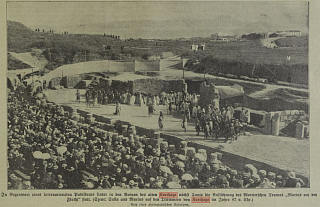
,5.6.1913
Carthage is mentioned by a soldier who is a teacher in civilian life. It concerns how sun spots can cause disasters on earth, as the conquest of Carthage. The conversation took place at the military hospital at Karlovo náměstí (see Vojenská nemocnice na Karlově náměstí).
Carthage is mentioned again by Einjährigfreiwilliger Marek, where he in the arrest in Budějovice tells how his complacency led to his expulsion from the officer's school.
Background
Carthage was an ancient city state at the coast of North Africa, south of Lake of Tunis in modern Tunisia. At its prime it is believed to have had up to 700,000 inhabitants. The Phoenician city was an important sea power.
The city was destroyed by the Romans after the Punic Wars in 146 BC and this is the event both conversations in the novel refers to.
Quote(s) from the novel
[I.13] Jeden voják, učitel z povolání, jako by četl jeho myšlenky, poznamenal: „Někteří učenci vysvětlují válku objevením se skvrn na slunci. Jakmile taková skvrna se udělá, tak přijde vždy něco hrozného. Dobytí Karthaga...“
[II.2] Svou zpověď zakončil jednoroční dobrovolník slavnostně: „Došlo i na Karthago, z Ninive udělali zříceniny, milý příteli, ale hlavu vzhůru! Ať si nemyslí, že když mne pošlou na front, že dám jednu ránu. Regimentsraport! Vyloučení ze školy!
Also written:KarthagoHašekKartágoczKarthagode
Literature
- V zajetí Kartagiňanú, ,1925
 | Mount Pelée |  | |||
| |||||
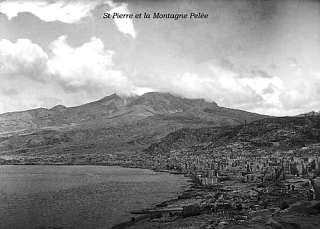
Saint-Pierre after the eruption in 1902.
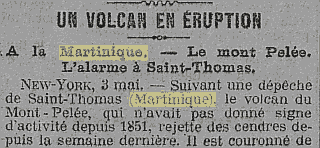
,4.5.1902
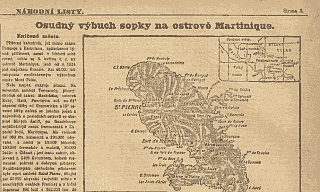
, 15.5.1902

, 10.5.1902
Mount Pelée and the volcanic eruption here "that time" is the theme in a dialogue at the military hospital (see Vojenská nemocnice na Karlově náměstí) where Švejk and Feldkurat Katz administer the last rites to wounded soldiers. The conversation circles around sunspots and that some professor had written in Národní politika that years ago he had warned that sunspots cause disasters on planet earth.
Background
Mount Pelée is a volcano at the north-western part of the French Caribbean island Martinique. It had an explosive eruption on 8 May 1902 that caused an estimated 30,000 casualties. The island's main city, Saint-Pierre, was totally destroyed and only few of its citizens survived. Švejk is however imprecise when he claims that the eruption destroyed the whole island of Martinique. It was mainly Saint-Pierre and the northern part of the island that were hit.
Already early that year volcanic activity was observed and on 23 April 1902 the eruption started. Early in May the situation had become serious, with ash raining down on the surrounding areas. In the morning of 4 May there was a larger eruption, resulting in a mudslide that destroyed a sugar factory and caused the death of at least 23 people. Many had already been killed by poisonous insects and snakes that fled from the area around the volcano. The same day the governor informed the French minister of colonies about the eruption, and the press around the world now reported the event (including newspapers in Vienna).
Then within a few days the great disaster struck. On 8 May at 7:52 in the morning the volcano literally exploded and dispatched a cloud of burning ash and gases (pyroclastic flow) towards Saint-Pierre. It took only one minute for the cloud to hit the city where it killed the inhabitants instantaneously. They died by the heat and the shock wave. Everything flammable caught fire and the city was levelled to the ground. Ships anchoring in the harbour were also destroyed. During the summer smaller eruptions caused further destruction and loss of human life.
The professor
The professor that the good soldier refers to was by near certainty Professor Zenger.
Quote(s) from the novel
[I.13] Když tenkrát ta sopka Mont-Pellé zničila celý ostrov Martinique, jeden profesor psal v ,Národní politice’, že už dávno upozorňoval čtenáře na vekou skvrnu na slunci.
Credit: Simone Chrétien
Also written:Mont-PelléHašekMont Peléecz
Literature
- Fiche scientifique - Les grandes catastrophes, ,2007
- L'eruption de la Martinique, ,6.5.1902
- Rædselsfuld ulykke, ,9.5.1902
- Eine zerstörte Stadt, ,9.5.1902
- Strašná katastrofa výbuchem sopky ve střední Americe., ,10.5.1902
- Der tag des Todes in St. Pierre, ,4.6.1902
- Sopečné výbuchy na ostrově Martinique, ,2.10.1902
 | Martinique |  | |||
| |||||
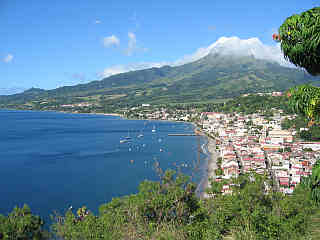
Saint-Pierre today.

,4.5.1902
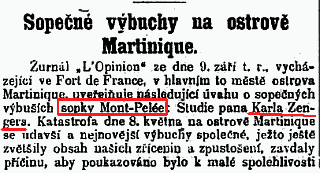
,2.10.1902
Martinique sunspots and the eruption at Mount Pelée is the theme of the dialogue at the military hospital where Švejk and Feldkurat Katz administer the last rites. Švejk connects the disaster to sunspot activity based on what he had read in Národní politika where a professor wrote that he already had warned about a big sunspot.
Background
Martinique is and island in the Small Antilles in the Carribean Sea and a French overseas département. The island is located about 450 north east of the South American coast and 700 km south east of the Dominican Republic. The island is as part of France, member of the EU, and the currency is Euro. The population count in 2014 was around 384,000.
Disastrous eruption
The volcanic eruption referred to in the novel happened on 8 May 1902 and was reported in Czech newspapers two days later. See Mount Pelée for more information about the disaster.
The professor
The professor that the good soldier refers to was by near certainty Professor Zenger.
Quote(s) from the novel
[I.13] Když tenkrát ta sopka Mont-Pellé zničila celý ostrov Martinique, jeden profesor psal v ,Národní politice’, že už dávno upozorňoval čtenáře na velkou skvrnu na slunci.
Also written:Martinikcz
Literature
- Fiche scientifique - Les grandes catastrophes,
- L'eruption de la Martinique, ,6.5.1902
- Eine zerstörte Stadt, ,9.5.1902
- Rædselsfuld ulykke, ,9.5.1902
- Strašná katastrofa výbuchem sopky ve střední Americe., ,10.5.1902
- Der tag des Todes in St. Pierre, ,4.6.1902
- Sopečné výbuchy na ostrově Martinique, ,2.10.1902



|
I. In the rear |
 | |
13. Švejk goes to provide the last rites | |||
| © 2008 - 2024 Jomar Hønsi | Last updated: 20.11.2024 |


